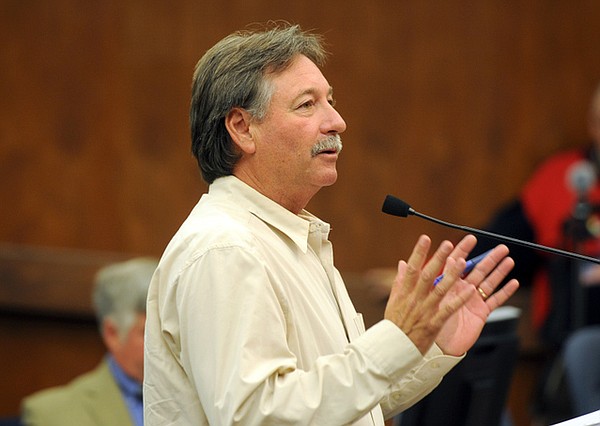Santa Ynez Water Agency Quits Cachuma Operations Board
Says Board is Spending too Much Money and Water on Fish Passage Projects

As if five years of drought weren’t bad enough, a long-simmering internal conflict has boiled over at the agency that delivers water to the Santa Ynez Valley and South Coast from Lake Cachuma, or what’s left of it.
In an angry May 27 letter to the Cachuma Operation and Maintenance Board (COMB), the Santa Ynez River Water Conservation District, Improvement District No. 1 announced its withdrawal from the board, alleging “disregard for the rule of law.”
Specifically, the district contends that COMB is conducting a federally-mandated steelhead trout monitoring and protection program below Bradbury Dam without authorization from the U.S. Bureau of Reclamation, spending too much money on fish passage projects and allowing too much water to flow downstream for the steelhead.
“COMB has turned into a fish advocacy agency,” Chris Dahlstrom, the district general manager, said in an interview. “ID No. 1’s purpose is to protect our water rights and our water supplies.”
In a stiffly-worded reply on June 3, Doug Morgan, president of COMB, said the board was “obviously disappointed” that Santa Ynez ID No. 1 chose unilaterally to withdraw while making a “continued recitation of unfounded and demonstrably inaccurate claims.”
“Regrettably, as it has done on several previous occasions, COMB must again object to and strenuously disagree with the claims and allegations made in the District’s letter,” Morgan said. “Rather, these allegations appear to be a re-hash of long-standing assumptions and perceptions held by the District, which no amount of accurate information or reality has apparently been able to dispel.”
COMB is responsible for the diversion of lake water to the South Coast through the Tecolote Tunnel, and it operates the South Coast Conduit pipeline from the tunnel to the Carpinteria reservoir. Santa Ynez ID No. 1, serving Solvang, Santa Ynez, and Los Olivos, was the only COMB member located downstream of the dam and not on the South Coast.
Under a contract with the Bureau of Reclamation and the county water agency, Santa Ynez ID No. 1 remains part of the Cachuma Project and gets 10 percent of yearly allocations from the lake. The Goleta, Santa Barbara, Montecito, and Carpinteria water agencies get 90 percent. They are the remaining members of COMB.
Steelhead, a form of rainbow trout, are an endangered species in Southern California. Only a few hundred juvenile trout survive in the river and creeks below Bradbury Dam. In 2011, COMB took over the fish management program from the Cachuma Conservation and Release Board, at that time composed of the same members as COMB.
In the past, ranchers downstream of Bradbury Dam have vigorously opposed fish passage projects in the Santa Ynez River and its tributaries, and challenged COMB’s authorization to build them.
“I understand the frustration and the concerns that ID No. 1 has raised,” said Charles Hamilton, the outgoing general manager of the Carpinteria Valley Water District. “A lot of their knowledge about downstream users will be lost. It’s a little bit like Brexit, now that they’ve voted to leave. What does it mean?”
COMB has a budget of about $8 million yearly, including $3 million for trout monitoring below Bradbury Dam. Roughly a third of the fish management program is paid for with state and federal grants.
In his letter, Morgan told Santa Ynez ID No. 1 it must pay $92,600 for its share of fish program assessments owed since September 2015. The district, in turn, has asked to see the books: it contends that COMB’s grant monies covered some of the bill. In previous years, the district had paid hundreds of thousands of dollars for the fish management program under protest.
In its letter to COMB, Santa Ynez ID No. 1 further alleged the agency had underestimated the cost of projects to avoid triggering the $1 million level that required a unanimous vote; failed to address “deficiencies and inequities” in water accounting from the lake; repeatedly violated the Brown Act by not allowing Santa Ynez representatives to attend public meetings; and made “unprovoked personal assaults on the District’s representatives.”
“These are problems that have occurred over many years and accumulated to the point where the ID No. 1 board has determined that it was not in its best interests to continue participating in COMB,” Dahlstrom said. “The district has tried to resolve these conflicts, but has been unsuccessful.”



